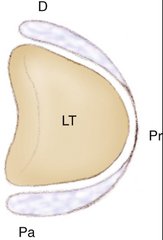CHAPTER 40 Kinematics of the Lunotriquetral Joint
Lunotriquetral injury is less frequently seen with distal radius fracture than one of the triangular fibrocartilage complex (TFCC) or scapholunate ligament injuries. One of the problems with lunotriquetral disorders is that most patients have normal imaging studies and fall under the broad and often vexing category of patients with ulnar-sided wrist pain. However, these disorders can have devastating effects on carpal mechanics and, unless properly treated, disruptions of the lunotriquetral supporting ligaments may result in substantial instability of the carpus. Knowledge of these effects and potential consequences will aid the treating physician in offering the patient the best possible outcome.
Functional Anatomy
Joint Anatomy
The relevant midcarpal articulation is between the distal articular surfaces of the lunate and triquetrum and the proximal surfaces of the capitate and hamate. A sagittal ridge can divide the lunate articular surface into a radial and ulnar fossa, and in these cases the proximal surface of the hamate articulates with the lunate. The incidence of this type II lunate varies considerably and is reported in 27% to 63% of adults.1,2 Otherwise, the distal surface of the lunate is concave in both coronal and sagittal planes.
The hamate-triquetral articulation has a helicoid or screw-shaped configuration. The plane of the joint is not parallel to the articular surface of the distal hamate with the fourth and fifth metacarpals but is situated at a substantial angle (reported as high as 90 degrees3).
Ligament Anatomy
The lunotriquetral joint is stabilized by an intricate arrangement of ligaments (Fig. 40-1). The intrinsic (both origin and insertion are within the carpus) lunotriquetral ligament is “C” shaped and is actually composed of three discrete regions: true ligaments dorsally and palmarly with collinear fascicles of collagen and a proximal region composed of fibrocartilage (Fig. 40-2). This proximal region has a wedge-shaped cross-sectional geometry and is reminiscent of a meniscus. In normal subjects there should be no communication between the midcarpal and radiocarpal joints but the proximal region of the lunotriquetral joint can be perforated by age. Because the proximal membrane contributes very little to the overall lunotriquetral stability, a defect at this level is not a sign of instability but can be a normal physiological, albeit age-related, finding, caused by wear. Mikic4 found up to 55% of lunotriquetral perforations past the third decade.
Radioulnocarpal Ligaments
Most extrinsic ligaments across the radioulnocarpal joint are obliquely oriented relative to the longitudinal axis of the forearm. Based on this, they may be subdivided into two groups: ligaments that prevent excessive passive supination of the proximal row relative to the forearm (anti-supination ligaments) and ligaments that control passive pronation (anti-pronation ligaments).5,6
Three ligaments act synergistically to prevent the proximal row to passively supinate beyond normal. The first is the palmar ulnotriquetral ligament that originates at the fovea near the base of the ulnar styloid. In approximately 90% of normal adults, the ulnotriquetral ligament is split distally to form an orifice that connects the radiocarpal and pisotriquetral joints.7 Second is the ulnolunate ligament that arises from the palmar edge of the triangular fibrocartilage (TFC) and runs obliquely toward its distal insertion into the anterior aspect of the lunate. Palmar to the ulnolunate and ulnotriquetral ligaments is the ulnocapitate ligament, which reinforces both these ligaments before passing anterior to the lunotriquetral joint, where it interdigitates with the fibers of the palmar region of the lunotriquetral interosseous ligament. It arises from the ulna at the fovea where the dorsal and palmar radioulnar ligaments also attach. Third, the dorsal radiotriquetral ligament is a wide, fan-shaped ligament that connects the dorsal edge of the distal radius to the dorsal rim of the triquetrum.8–12
Midcarpal Ligaments
The ulnar limb of the arcuate ligament, also known as the palmar triquetrum/hamate/capitate ligamentous complex, strongly connects the triquetrum to the distal carpal row.10,13–16 It consists of a group of fan-shaped fascicles formed by dense collagen fibers that links the distal anterior edge of the triquetrum to the palmar aspects of the hamate and capitate. This ligament can be regarded as an anti-supination ligament. The only dorsal midpalmar crossing ligament is the dorsal intercarpal ligament. It arises from the dorsal ridge of the triquetrum, courses transversely along the distal edge of the lunate, and fans out to insert on the dorsal rim of the scaphoid, the trapezium, and the trapezoid bones.8,10,17 This ligament can be characterized as an anti-pronation ligament.
There is no dorsal or ulnar ligament between the triquetrum and hamate. Because the midcarpal joint is not a true hinge articulation, there are no vertically oriented ligaments. Their absence is functionally substituted by the extensor carpi ulnaris tendon, which is a thick sheath that may act as a dynamic joint stabilizer.18
Mechanics
Material and Constraint Properties
Results of material property testing of the lunotriquetral ligament showed that the palmar region of the ligament is not only thicker but indeed stronger than the dorsal portion of the ligament (average yield strengths: 301 N and 121 N, respectively).19 The palmar region was found to constrain primarily translation, whereas the dorsal region provides the majority of rotational constraint. The fibrocartilaginous proximal region failed at 64 N and was the least important constraint in all directions. The morphology and material and constraint properties of the lunotriquetral ligament are the exact opposite as found in the scapholunate ligament.20 In a way, the lunate could be thought of as a “torque-suspended” bone between the scaphoid and the triquetrum, much in the manner of a spring. This “torque suspension” concept, for which there is now sufficient evidence, is of importance for the discussion and understanding of dorsiflexed intercalated segment instability (DISI) and volar-flexed intercalated segment instability (VISI).
Recently, immunohistochemical analysis of wrist ligament innervation showed that sensory important ligaments were primarily related to the triquetrum while mechanically important ligaments were primarily located in the radial, force-bearing column of the wrist. The triquetrum and its ligamentous attachments are regarded as key elements in the generation of the proprioceptive information necessary for adequate neuromuscular wrist stabilization.21









